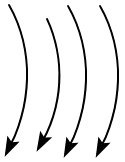(Take \(g=10~\text{ms}^{-2}\))
1. \(2\times10^3~\text{kg}\)
2. \(3\times10^4~\text{kg}\)
3. \(5\times10^4~\text{kg}\)
4. \(7\times10^4~\text{kg}\)

To unlock all the explanations of this course, you need to be enrolled.

To unlock all the explanations of this course, you need to be enrolled.
A liquid is poured into three vessels of the same base area and equal heights as shown in the figure, then:

| 1. | The maximum force on the base will be for the vessel \(C.\) |
| 2. | The maximum force on the base will be for the vessel \(B.\) |
| 3. | The maximum force on the base will be for the vessel \(A.\) |
| 4. | Force on the base will be equal for all the vessels. |

To unlock all the explanations of this course, you need to be enrolled.

To unlock all the explanations of this course, you need to be enrolled.
The area of cross-section of the wider tube shown in the figure is \(800~\text{cm}^2.\) If a mass of \(12~\text{kg}\) is placed on the massless piston, then the difference in heights \(h\) of the levels of water in the two tubes will be:

| 1. | \(10~\text{cm}\) | 2. | \(6~\text{cm}\) |
| 3. | \(15~\text{cm}\) | 4. | \(2~\text{cm}\) |

To unlock all the explanations of this course, you need to be enrolled.

To unlock all the explanations of this course, you need to be enrolled.
The value of g at a place decreases by 2%. Then, the barometric height of mercury:
| 1. | increases by 2%. | 2. | decreases by 2%. |
| 3. | remains unchanged. | 4. | sometimes increases and sometimes decreases. |

To unlock all the explanations of this course, you need to be enrolled.

To unlock all the explanations of this course, you need to be enrolled.
The height of a mercury barometer is \(75 ~\text{cm}\) at sea level and \(50 ~\text{cm}\) at the top of a hill. The ratio of the density of mercury to that of air is \(10^4.\) The height of the hill is:
| 1. | \(250 ~\text m\) | 2. | \(2.5 ~\text {km}\) |
| 3. | \(1.25 ~\text {km}\) | 4. | \(750 ~\text m\) |

To unlock all the explanations of this course, you need to be enrolled.

To unlock all the explanations of this course, you need to be enrolled.
A vertical \(\mathrm{U}\)-tube of uniform inner cross-section contains mercury in both its arms. A glycerin (density\(=1.3\) g/cm3) column of length \(10\) cm is introduced into one of its arms. Oil of density \(0.8\) g/cm3 is poured into the other arm until the upper surfaces of the oil and glycerin are at the same horizontal level. The length of the oil column is:
(density of mercury \(=13.6\) g/cm3)
1. \(10.4\) cm
2. \(8.2\) cm
3. \(7.2\) cm
4. \(9.6\) cm

To unlock all the explanations of this course, you need to be enrolled.

To unlock all the explanations of this course, you need to be enrolled.
A barometer kept in a stationary elevator reads \(76 ~\text{cm}.\) If the elevator starts accelerating up, the reading will be:
1. zero
2. equal to \(76 ~\text{cm}\)
3. more than \(76 ~\text{cm}\)
4. less than \(76 ~\text{cm}\)

To unlock all the explanations of this course, you need to be enrolled.

To unlock all the explanations of this course, you need to be enrolled.
| 1. | \(P_P=P_Q=P_R=P_S\) | 2. | \(P_P>P_Q>P_R>P_S\) |
| 3. | \(P_P<P_Q<P_R<P_S\) | 4. | The data is insufficient to predict the relation |

To unlock all the explanations of this course, you need to be enrolled.

To unlock all the explanations of this course, you need to be enrolled.
Which of the following diagrams does not represent a streamline flow?
| 1. |  |
2. |  |
| 3. |  |
4. |  |

To unlock all the explanations of this course, you need to be enrolled.

To unlock all the explanations of this course, you need to be enrolled.
Three liquids of densities \(d,\) \(2d\) and \(3d\) are mixed in equal proportions of weights. The relative density of the mixture is:
| 1. | \(11d \over 7\) | 2. | \(18d \over 11\) |
| 3. | \(13d \over 9\) | 4. | \(23d \over 18\) |

To unlock all the explanations of this course, you need to be enrolled.

To unlock all the explanations of this course, you need to be enrolled.







